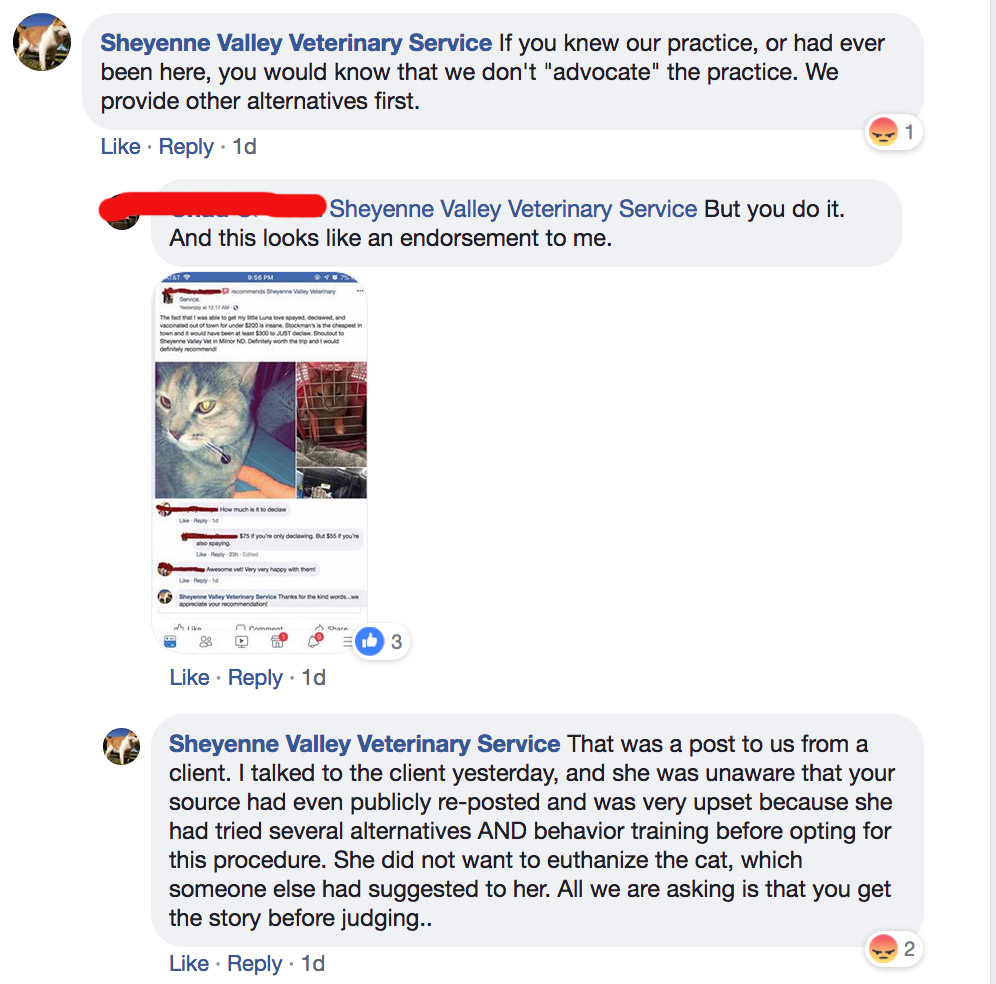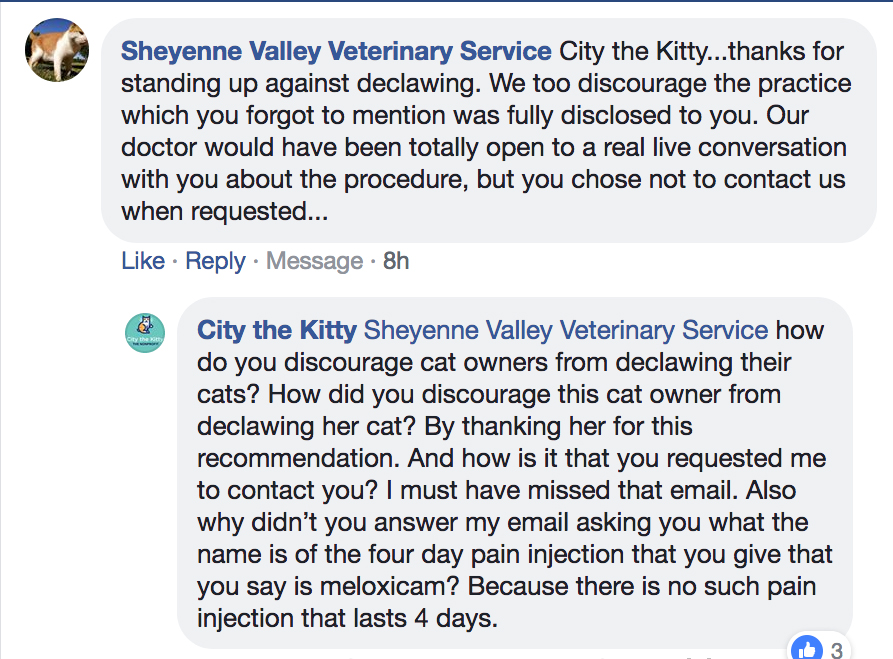This review was posted in November 2018 on Sheyenne Valley Veterinary Service’s facebook page and was sent to me by a supporter.
—————————————————————————————–
November 2018
Comment posted by Sheyenne Valley Veterinary Service in North Dakota on a post I did about this practice that does several $55 declaws a week (according to the declawing vet. )
The purpose of this story is to educate the public about how declawing is never necessary and is always harmful to the health and well-being of a cat. It’s also to get the FACTS out about this issue.
—————————————————————————-
The public needs to be educated about the fact that many declawing vets are not giving cats the proper pain management protocols after they amputate their kitties toe bones and claws. These cats are going through unimaginable pain and suffering. Examples of Cats Declawed With No Pain Meds
Please always remember to take the high road and educate!
Before I posted the screenshot of this review and photo about a kitty that she declawed, I sent this vet a private email and she called it an attack on her clinic.
Not once did I question all the good things that she does for animals. I simply wanted to ask questions about how she addresses declawing and why she isn’t giving cats the proper pain management protocols after she slices off their toe bones and claws with her $55 declaw.
I had follow-up questions including some about her Meloxicam injection that she says lasts 4 days, but she deflected and said “And still you have failed to include YOUR contact information or educational degree. I think you can find another tree to bark up today.. thanks for your time, but I think we are done. KP.”
My researcher called her clinic and asked for a price of a neuter and declaw. Dr Kathy spoke to them on the phone and she NEVER said that there could be serious complications after a declaw and in fact said to them, “If they’re indoors only that’s certainly a viable option for you.” The researcher asked if she sees any problems with cats coming back and Dr Kathy said, “Nope.“
She said that she is not a big fan of declawing cats but also said she does several of them a week. Not once did she ask about scratching issues with the cat or mention any humane options.
More about this below.
———————————————————————————
I wanted to see how this vet practice addresses declawing to cat owners who call for a price, so one of my researchers called the practice to get a price for a neuter/declaw. (This way is usually the only way to get an accurate idea of how a declawing vet practice addresses declawing.)
The vet, Dr Kathy Pfingsten, was the one who answered the phone and the conversation was as follows.
Researcher called Sheyenne Valley Veterinary Service in North Dakota and asked to get a cat neutered.
Dr Kathy asked if it’s a male cat and the researcher said yes.
Dr Kathy said that they are having a special this month for $20 cat neuters.
The researcher asked if there is anything else that people get done that she recommends.
Dr Kathy said that you should get vaccinations and at the minimum, rabies.
The researcher said if a cat has it’s vaccination is there anything else that people have done when the cat’s put out like that?
Dr Kathy said, “I guess some people declaw them.”
Researcher asked if they do them there.
Dr Kathy said yes, they are a full service vet clinic.
The researcher asked how much extra is a declaw.
Dr Kathy said that it’s $55. She said that typically their neuters are $90 plus $55 for the declaw but this month they are running a special and it would be $75 total.
Researcher asked if they do the declaw with a laser.
Dr Kathy said they don’t use a laser and said, “I actually feel more comfortable not doing that because of the procedure. You are actually amputating the last digit of the finger so we feel more comfortable just using tissue glue and manual dissection of that last joint.
She was asked how she manually dissects the last joint and she said, “With a scalpel. “
Researcher said that their husband said to not get a vet that does declaws once a year because the cat might be limping.
Dr Kathy said, “No, we do several a week.”
Researcher asked if cats are OK long-term after two weeks?
Dr Kathy said, “yea we typically leave them wrapped for 24 hours after surgery and then they are pretty tender for about a week.”
Researcher asked if long-term their cat will be ok because they read some horror stories on the internet that it’s not good for the cat.
Dr Kathy said, “Yep.”
Researcher asked, “They will be alright?”
Dr Kathy said, “It is a major surgery because you are amputating part of their fingers.”
Researcher said that they thought if they perform declaws then it’s not bad for their cat long-term and asked if they have any problems?
Dr Kathy, “Well yeah a lot of people do it. Personally I’m not a big fan of declawing just because I don’t like amputating their fingers.” She said that a lot of people do declaws and have to do it for apartments and things like that.
Dr Kathy said, “If they’re indoors only that’s certainly a viable option for you.”
Researcher asked, “You don’t see any problems with them coming back?”
Dr Kathy said, “Nope.”
Researcher asked about the pain med protocol and Dr Kathy said that she doesn’t give take home meds for the declawed kitty, because it’s hard to pill a cat. She said that she gives them an injection called Meloxicam and said it is a 4 day injection.
(FYI, according to 3 veterinarians, there is no Meloxicam injection that lasts 4 days.)
This comment was posted by Sheyenne Valley Veterinary Service after I did a post about the cat owner’s review. The public needs to be educated about the fact that their cats are having their toe bones sliced off and are NOT getting any pain meds for this very painful procedure.
I reached out to 4 veterinarians and asked them if they knew about a Meloxicam 4 day injection in cats that helps with pain. All of them said that there is no such thing. All of these veterinarians do not perform declaws.
One of them, Dr Robin Downing, of the Downing Center for Animal Pain Management in Windsor, CO., who is an expert at pain management and who is a no-declaw veterinarian said this after we told her that a declawing vet in ND just gives a MELOXICAM injection to the cats that she declaws and says it lasts for 4 days for the pain relief.
Dr Robin Downing’s comments,
“This statement is patently FALSE! There is NO meloxicam that lasts more than 24 hours.
If meloxicam is to be used responsibly, it must be used with complete transparency and informed consent by the client. That means using it at LOWER than the current label dose for injectable meloxicam, which can then be followed by several days of oral meloxicam (this is in contrast to the “black box” warning that states that oral meloxicam should not be given to cats).
We actually have excellent data to let us know that several days of oral (liquid) meloxicam – – at lower doses than were originally discussed here in the US – – provides cats with excellent pain relief and eliminates the worry about giving tablets.
We MUST have a candid conversation with clients in order that they understand that this usage is outside the bounds of the FDA label. But that is what a good doctor-client relationship and effective communication are all about.
In addition, it is completely unconscionable that these cats are not receiving Simbadol, the 24 hour buprenorphine that was specifically developed for use in cats and is a Zoetis product. These cats can receive a dose the day of surgery, and then they can receive a second dose the day after – – before they go home. In my practice, clients are happy to return so that their cats can receive the 3rd dose that is part of the FDA label for the product. They see how well their cats feel. There is no reason that these cats, considering the torturous pain of toe amputation, could not benefit from receiving the three day/three dose Simbadol protocol.
The buprenorphine complements the meloxicam (it works by a different pathway in the body) and provides a MUCH more effective pain relieving strategy than either drug by itself.
Cats who have their toes amputated must have gabapentin as part of their pain management protocol.
This veterinarian, if your details are accurate, is actually malpracticing by violating a minimal standard of pain care. In addition, she is violating foundational bioethical principles by torturing these cats with unrelenting pain that will very likely lead to a permanent pain state for most of them.”
Dr Downing, who is adamantly opposed to declawing cats, went on to say,
“They need 3 pieces to their pain management.
-
NASID (either meloxicam or Onsior)
-
Simbadol for 3 days.
-
Gabapentin for 2 weeks.
———————————————————————————————–
Just so that there are no questions about how this conversation went with this declawing veterinarian in North Dakota, here are the emails.
November 11, 2018
Dear Dr Kathy,
I’m the mom of City the Kitty. I was a photojournalist at the Los Angeles Times for 25 years and now write stories on City’s website, citythekitty.org. City is the number one spokescat to end declawing. We get a lot of tips from supporters who are helping this cause and who care about the welfare of cats.
I’m taking the time to write you because I always believe that it’s never too late and everyone can have a change of heart and do the right thing. My goal is to educate the public about declawing and about the humane options and to try to inspire declawing veterinarians to do the right thing and stop doing this inhumane procedure on cats.
When they know better, they are doing better. More and more studies and information is coming out that shows how harmful declawing is to the health and well-being of a cat.
I received a tip about you and your practice and how you address declawing and many would agree with me when I say what I found out was appalling and quite disheartening.
You declaw cats for $55. You have people coming from out of town because your declaws are so cheap. Cats that have had their toe bones sliced off need lots and lots of pain meds yet you don’t give them any. This is both shocking and frightening to think about the suffering those poor kitties are going through after they leave your practice. You do several declaws a week when you could be educating these clients about how horrible a declaw is for a cat’s well-being and you could be counseling them about the humane options like scratching posts, nail trims, deterrents, Soft Paws, etc. Cats are sent home with those tight bandages on, when so many times it could cause the cat’s tissue to lose the blood supply and cause serious problems if left on too long. Here’s one example of that happening – https://citythekitty.org/3-kitties-declaw-story/
Do you know that 42 countries around the world ban declawing because they know it is inhumane. I’m not sure if you are aware but thankfully Canadian veterinarians are voting to ban declawing. More and more veterinarians in America have stopped performing this inhumane and mutilating procedure. They are actually getting more clients who want to take their pets to an ethical, no-declaw practice. Some of them are even joining the accomplished pawproject.org team of humane veterinarians who are on the right side of history and want to help end this barbaric procedure. They are repairing the paws of declawed cats in need.
Humane veterinarians choose to educate their clients about why they should never declaw their cats and about the easy, humane options. They are honoring their oath to ease the suffering in animals and are not causing it by declawing them. Good veterinary clinics that practice quality medicine would be never treat cats the way you have chosen to.
Your declaw price is the lowest I’ve ever heard of in the entire time I have been working on this cause. How can you say you don’t like doing them, when you encourage clients to drive from miles away by offering to chop their cat’s toes off for practically free? No veterinarian can properly perform multiple amputations with appropriate pain modulation for the price of $55. I can only assume that you are cutting costs everywhere, especially when addressing an animal’s need for pain control following the removal of their toe bones.
When they know better, they do better. You aren’t that old and it’s not too late for you to make a difference and help the welfare of cats. I’m happy to offer you any resources or advice about this. I have many friends who are no-declaw vets and they thank me for inspiring them to stop. They said it made such a huge difference in their life and they regret ever doing declaws. But they are now doing so much to help the cause and save other cats from this barbaric and mutilating procedure. Some of the most accomplished veterinarians in the world help me with advise and information for my stories and posts. Just think how it could change your life for the better too.
I sure hope you think about why you joined this noble and honorable profession and how you wanted to help ease the suffering in animals and heal and help them.
Perspective is everything Kathy. I hope you take this note to heart
Sincerely,
Lori Shepler and City the Kitty
November 11, 2018
And still you have failed to include YOUR contact information or educational degree. I think you can find another tree to bark up today.. thanks for your time, but I think we are done. KP
“This statement is patently FALSE! There is NO meloxicam that lasts more than 24 hours.
If meloxicam is to be used responsibly, it must be used with complete transparency and informed consent by the client. That means using it at LOWER than the current label dose for injectable meloxicam, which can then be followed by several days of oral meloxicam (this is in contrast to the “black box” warning that states that oral meloxicam should not be given to cats).
We actually have excellent data to let us know that several days of oral (liquid) meloxicam – – at lower doses than were originally discussed here in the US – – provides cats with excellent pain relief and eliminates the worry about giving tablets.
We MUST have a candid conversation with clients in order that they understand that this usage is outside the bounds of the FDA label. But that is what a good doctor-client relationship and effective communication are all about.
In addition, it is completely unconscionable that these cats are not receiving Simbadol, the 24 hour buprenorphine that was specifically developed for use in cats and is a Zoetis product. These cats can receive a dose the day of surgery, and then they can receive a second dose the day after – – before they go home. In my practice, clients are happy to return so that their cats can receive the 3rd dose that is part of the FDA label for the product. They see how well their cats feel. There is no reason that these cats, considering the torturous pain of toe amputation, could not benefit from receiving the three day/three dose Simbadol protocol.
The buprenorphine complements the meloxicam (it works by a different pathway in the body) and provides a MUCH more effective pain relieving strategy than either drug by itself.
This veterinarian, if your details are accurate, is actually malpracticing by violating a minimal standard of pain care. In addition, she is violating foundational bioethical principles by torturing these cats with unrelenting pain that will very likely lead to a permanent pain state for most of them.”
I received no response from Dr Kathy to those two important emails.
Here’s a comment on a review on Sheyenne Valley Veterinary Service’s facebook page about why this cat owner had her cat declawed. 


